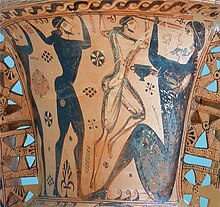Polyphemus painter

The Polyphemus Painter was a Middle Protoattic vase painter who worked in Athens or on Aegina . He is considered one of the innovators in Attic art and introduced several mythological themes into Attic art. The painter's works date from 670 to 650 BC. Dated. He was probably not only the vase painter, but also the potter of the vessels he painted.
The Polyphemus painter was probably a pupil of the Mesogeia painter . It got its emergency name from a picture on a neck amphora that was found in Eleusis and had served as a child's grave vase. The portrait of the neck, which shows the blinding of Polyphemus , and the portrait of the belly with Perseus and the Gorgons belong to the first interpretable representations of Greek mythology on vase pictures. In the Antikensammlung Berlin there were two stands that were decorated by the Polyphemus painter, one of which, inventory number A42, was lost in the Second World War. While a similar procession of men with spears was depicted on both of them, the name Menelas ( Menelaus ) was inscribed on one of the figures on the lost stand , which is the first known painted inscription in Attic art. It is written in the Doric dialect , which was untypical of Attica, but was spoken in Aegina. Since all the characters are wearing identical clothing, the group of men may be a choir. It was therefore suggested that the inscription should be understood as the chant's song, as the Doric dialect was used for choral songs. This interpretation was taken up by some researchers, but rejected by others and must be considered uncertain.
literature
- Thomas Mannack in Greek Vase Painting. An introduction , Theiss, Stuttgart 2002, pp. 135-136 ISBN 3-8062-1743-2
supporting documents
- ↑ see the article by G. Ferrari, Menelās, in: JHS 107, 1987, 180-182, to which Mannack refers.
Web links
| personal data | |
|---|---|
| SURNAME | Polyphemus painter |
| ALTERNATIVE NAMES | Polyphemmaler; Polyphemos Painter |
| BRIEF DESCRIPTION | Middle Protoattic vase painter |
| DATE OF BIRTH | 8th century BC BC or 7th century BC Chr. |
| DATE OF DEATH | 7th century BC Chr. |